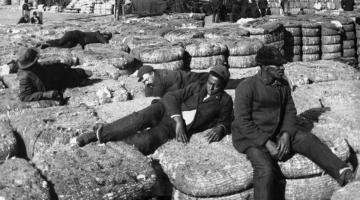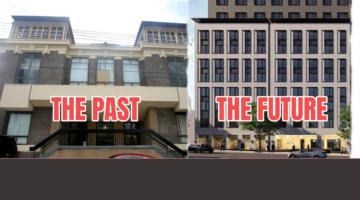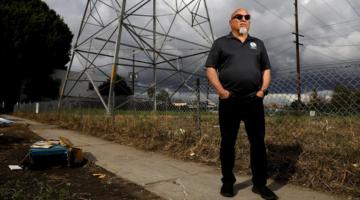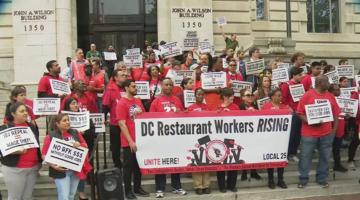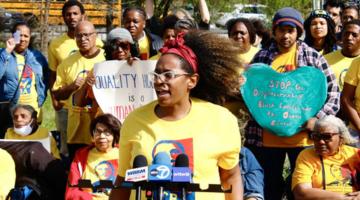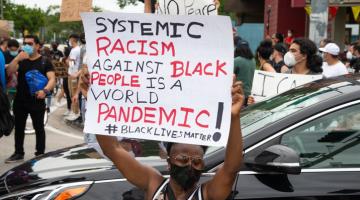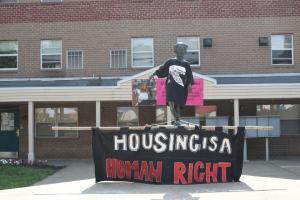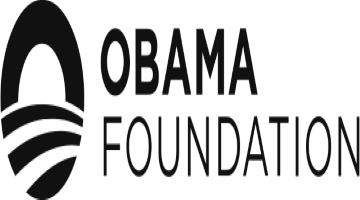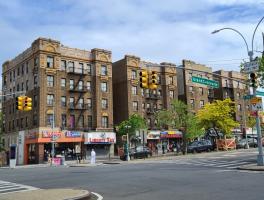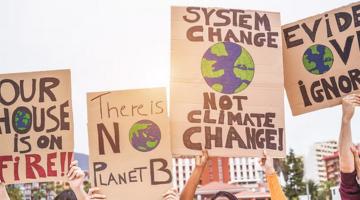School closings are central to gentrification and Black dispersal from prime urban real estate.
“We are not included in the blueprint of the new Chicago. We’re being pushed out.”
Ghosts in the Schoolyard: Racism and School Closings on Chicago's South Side
Eve L. Ewing
University of Chicago Press
Beginning in 2013, Chicago Mayor Rahm Emanuel unveiled an ambitious plan to shutter 330 underperforming public schools. The plan was soon whittled down to 54 schools citywide. Parents fought back in Bronzeville, an African American neighborhood on Chicago’s South Side. If these schools were as terrible as Chicago Public Schools (CPS) officials claimed, then why did parents and other residents use every tool at their disposal, including hunger strikes, to keep them open? Eve Ewing, a University of Chicago’s School of Social Service assistant professor, who was born, raised and still lives in in the city, documents one community’s struggle against the fallout from gentrification in Ghosts in the Schoolyard: Racism and School Closings on Chicago’s South Side.
The starkly different perceptions of what a neighborhood school means to a community can be chalked up to the perniciousness of segregation and structural racism. CPS officials had resorted to steep budget cuts, whittling away at the schools year after year. As families moved out of the area seeking better neighborhood schools, the student population dwindled. The school district finally fell back on a devious argument. The buildings, the officials said, were underutilized. But the Bronzeville schools also did not have enough assistant principals, counselors, or teachers. As one teacher told Ewing, who taught in Bronzeville before the closings: “People will take everything you have, then blame you for having nothing.”
“CPS officials whittled away at the schools year after year.”
But where school system officials saw educational failure, parents saw vital African American institutions that had served families for generations. Parents developed close relationships with teachers and other school professionals—and some of them lived in the neighborhood. These families knew the teachers, participated in events at the schools, and continued school-based get-togethers after children graduated. The schools were like community centers, and teachers were familiar faces in the area.
Ewing reports that these closures caused what she calls “institutional mourning,” the experience of “individuals and communities facing the loss of a shared institution … such as a school.” Now these same institutions were at risk as wealthier white residents moved into black neighborhoods, attractively situated near Lake Michigan and the downtown Loop. Bronzeville was deliberately slated for gentrification, parents believed, as part of the mayor’s plan to remake Chicago—and the local schools were in the way. With the real estate market in Bronzeville heating up, the school closings were a convenient way for city officials to clear the neighborhood of African American undesirables. Chicago Teachers’ Union president Karen Lewis called the closures “explicitly racist.”
“Bronzeville was deliberately slated for gentrification as part of the mayor’s plan to remake Chicago.”
Brash and outspoken, Emanuel had little use for teachers’ unions and supported charter schools, the centerpiece of neoliberal public education reform: Emanuel effectively moved to privatize public schools, where possible using public money to fund the private companies and groups that opened new charter schools. Test scores, of course, were key to closure decision-making process. If a school had low test scores, it would be subject to pedagogical and administrative interventions up to and including closure.
The Chicago mayor has complete control of the school system, appointing all members of the school board including the chief executive officer, the system’s top official. So Emanuel became the target of Bronzeville’s enmity, especially since CPS showed little respect for parents or the wider community. There was little transparency about fundamental issues, including school closure hearing dates or any demonstrated concern about what would happen to students who were transferred elsewhere.
Parents believed that if student well-being was the issue, CPS should have deployed more academic supports and the requisite professionals to implement them. Moreover, CPS should have spent money to staff up and provide much needed textbooks and equipment to the old schools. “Students who experience school closures,” Ewing writes, “end up at new schools that are not thriving academically, so they don’t receive any boost or improvement in their education.”
“Emanuel effectively moved to privatize public schools.”
Bronzeville’s school closings are linked, Ewing argues, to racial segregation dating from the Great Migration. As Southern migrants moved to the city in the early 20th century, bank officials conspired with realtors to keep them out of white neighborhoods. The establishment of low-income public housing in places like Bronzeville in the 1940s exacerbated this development. The city went on a public housing building spree in in part to keep black children in black neighborhoods.
But as crime and drugs caused once flourishing public housing developments to spiral into decay, the city demolished many projects (like the Ida B. Wells Homes on the South Side). Families who could fled the area, leaving behind schools with fewer and fewer students. CPS forced more closures than the community believed were warranted: Similarly depopulated and thus “underutilized” schools in white neighborhoods did not experience as many closures.
Ewing focuses on three Bronzeville elementary schools that CPS determined were failing in 2013: Mayo, Overton, and Williams. CPS approached the closings, Ewing observes, “as if the timeline of everything we need to know somehow began with 2011 test scores.” CPS considered little else beyond test scores as criteria for closing schools, even though residents testified at closure hearings that CPS had facilitated the decline by ignoring the academic needs of the students and neglected to understand the important social supports they provided to neighborhood families.
“Bronzeville’s school closings are linked to racial segregation dating from the Great Migration.”
Destablizing black families, Ewing argues, has a long, racist pedigree. “Historically the intentional disruption of the African American family has been a primary tool of white supremacy,” Ewing writes, “one with deep roots extending from the time of chattel slavery through the present era of mass incarceration.” CPS also ignored that relocation also put students’ lives at risk, since they were forced to navigate longer distances in gang-infested areas. One teacher Ewing interviewed worries about how “to make sure [the students] can actually walk to and from school.”
But considerations of safety in a new environment, like the issues of poverty, hunger and homelessness that afflict many South Side students, are difficult to quantify when a CPS bureaucrat investigates school performance. If the old school has low-test scores and inadequate staffing and few students, why not close it, and send the students elsewhere? How the students get to that elsewhere and what that transition meant for their families was not part of the equation.
When CPS announced the closures, officials threw the community a bone: they held public hearings where parents and residents could air their opinions on an issue that had already been decided. One parent called the hearings “all bullshit. Public hearings are just there to let you talk. ‘We already know what we gonna do, but we’re giving you a chance to feel good about talking.’”
“One parent called the hearings ‘all bullshit.’”
It seems entirely credible that CPS never intended to disrupt the mayor’s plans for these neighborhoods, which, Ewing says, positioned “the destruction of black institutions as a necessary step toward beautification or marketability.” As a group of student-poets wrote at the time: “We are not included in the blueprint of the new Chicago/We’re being pushed out/Our buildings being transformed into condos/ And we know those ain’t for us.”
Chicago is not alone. Philadelphia has also shuttered dozens of schools, mostly in African American neighborhoods. Indeed, in many cities with a large, low-income black population, school closings are a familiar phenomenon and the children and their families are so much collateral damage. Ewing’s focus on racism and gentrification lays bare the flaws in the often-heard argument that “these are lousy, dangerous schools and everyone’s better off without them.” She underscores how that view conceals the stealthy forces of displacement and the pain of the dispossessed. Or, as Ewing puts it: “A school is a home. So when they come for your schools, they’re coming for you. And after you’re gone, they’d prefer you be forgotten.”
This article previously appeared in The American Prospectand Portside.
COMMENTS?
Please join the conversation on Black Agenda Report's Facebook page at http://facebook.com/blackagendareport
Or, you can comment by emailing us at comments@blackagendareport.com

